|
Posted 5/15/23
“LEGAL” GUN BUYERS CAN BE A PROBLEM
They figure in many killings, as both doers and enablers

For Police Issues by Julius (Jay) Wachtel. Does this image stir your memory? It depicts the Uvalde, Texas retailer where eighteen-year old Salvador Ramos bought the AR-15 style rifle he used to murder nineteen students and two teachers at Robb elementary school last year.
Oasis Outback (it’s still in business) was one of 52,799 licensed firearms dealers in the U.S. in 2020, and one of 10,635 in Texas. Only about one in four have a commercial storefront. Most licensees – estimates peg it at 74 percent – operate from their homes. Either way, the numbers are huge. And to partake of their goodies is ridiculously easy. Other than money, all one needs is to be of age – the Federal minimums for buying from a dealer are eighteen for a long gun and twenty-one for a handgun – and to be free from a felony conviction (18 USC 922[b] and [g]). A handful of states (not including Texas) have raised set the minimum for long-gun purchases at twenty-one. And to assure that criminal record checks are thorough and, ostensibly, to discourage impulsive purchases, several (again, excluding Texas) impose a few days’ wait before guns can be picked up.
And that’s about it.
Click here for the complete collection of gun control essays
Considering the quirks of human nature, America’s permissive approach to gun acquisition might seem an exercise in self-annihilation. Guns, though, have been an integral part of the sociocultural (and Constitutional) fabric since our nation’s founding. And thanks to a prolific firearms industry, our land is  awash with lethal toys. Just how “awash”? According to ATF (full disclosure: your writer’s one-time employer), gun manufacturers produced 13,804,919 firearms for non-military use in 2021. Of those, 458,684 were exported, leaving 13,346,235 to be distributed domestically. Again – that’s in a single year. Over time, the numbers are truly astounding. During 1986-2021, including imports (and excluding exports) 281,196,579 guns entered the domestic marketplace. awash with lethal toys. Just how “awash”? According to ATF (full disclosure: your writer’s one-time employer), gun manufacturers produced 13,804,919 firearms for non-military use in 2021. Of those, 458,684 were exported, leaving 13,346,235 to be distributed domestically. Again – that’s in a single year. Over time, the numbers are truly astounding. During 1986-2021, including imports (and excluding exports) 281,196,579 guns entered the domestic marketplace.
There is a small hitch. These quantities include guns (mostly, handguns) acquired by police. Large agencies that responded to a 2013 PERF survey reported buying an average of forty-four handguns per officer per year. Extended to all 18,000 state, county and Federal law enforcement agencies in the U.S., that’s well under one million. That leaves, um, twelve-million-plus new guns for resale to, well, you and me. Each year.
Americans readily admit they’re well-armed. Thirty-two percent of adult respondents to a 2020 Gallup poll reported owning a gun, and 44 percent said they lived in a household with a gun. Of course, there are consequences. Simple common sense suggests that more guns = more instances of impulsive misuse (see, for example, “Fearful Angry. Fuzzy-Headed. And Armed.”) According to a Rand report, increased gun availability is a likely explanation for the continuing uptick in suicide. A seemingly robust study published by the American Public Health Association noted that increased gun ownership during 1981- 2010 was associated with an increase in gun homicide.
Using CDC data we brought it together in a single graph:
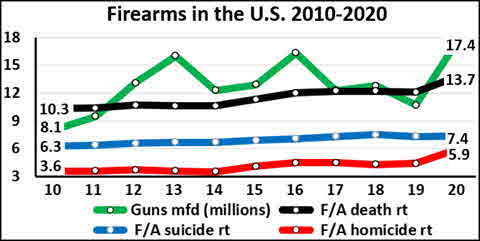
During 2010-2020, as gun production ramped up and guns piled up, the per/100,000 rates for gun deaths, gun suicides and gun homicides steadily increased. Statistically speaking, the relationship between gun manufacture and the other variables is moderately strong, with r’s (correlation coefficient, range 0-1) of .55 with firearm deaths, .49 with gun suicides, and .57 with gun homicides.
Of course, factors other than guns contribute to violence. One that we frequently turn to is economic conditions, measured by poverty (see, for example, “Worlds Apart”). Guns, though, are often the means. So how do evildoers get them? In this essay we’ll focus on what happens with guns, such as those acquired by Salvador Ramos, that are sold at retail. Several studies have confirmed that these ostensibly legal transactions can lead to poor endings:
- Our journal article, “Sources of Crimes Guns in Los Angeles, California”, reported that unlicensed “street dealers” and corrupt licensed dealers – particularly, those based at home – were sources of a substantial number of crime guns. Fourteen percent of a set of 1,599 firearms seized by L.A.-area police during 1988-1995 whose retail purchasers’ names were known were in fact recovered from their buyers (pg. 228).
- Twenty-seven percent of the inmates who responded to DOJ’s 1991 prisoner survey reported that they bought the gun they got caught with at a store. Ten percent said so on the 2016 survey (pg. 7).
- Violence Project’s database of 190 mass shootings between 1966 and 2021 reveals that eighty of 172 shooters (46.5%) legally acquired their guns, and that fifty-five (32%) purchased at least one from a licensed dealer.
- Twelve percent of the nearly one and one-half million crime guns traced by ATF during 2017-2021 were confiscated from their retail buyer (pg. 26.) This is unavoidably an underestimate, as possessor identities often go unreported to ATF. Even so, each year police are apparently seizing more than thirty-six thousand store-bought guns from their buyers.
The frightful carnage enabled by store-bought guns didn't end with Salvador Ramos. Here are three more recent examples:
- Louisville, Kentucky, April 10, 2023. Livestreaming his foul deed, 25-year old Connor Sturgeon opened fire with an AR-15 style rifle on his Louisville bank co-workers. By the time police shot him dead he had killed five. He also wounded eight persons, including two of the responding officers. Sturgeon legally purchased the weapon from a local gun dealer six days earlier.
- Nashville, Tennessee, March 27, 2023. Audrey Hale, a 28-year old Nashville resident, possessed two assault-style rifles and a handgun during his attack at Covenant Christian School. Unleashing 152 rounds, he murdered three employees and three nine-year old students. Hale bought these guns and four more at five different gun stores between 2020-2022.
- Chesapeake, Virginia, November 22, 2022. Andre Bing, a 31-year old Walmart night shift supervisor, purchased a 9mm. pistol at a gun store in the morning. Some hours later he fatally shot six co-workers, then committed suicide.
Is there anything that might have prevented these massacres, or at least mitigated their effects?
 According to Giffords, ten states and D.C. ban assault weapons. But none of our three assault-rifle-packing killers – Ramos (weapons on left), Sturgeon and Hale – lived in any of those states. In any event, such “bans” are no solution. As our prior posts (for example, “Ban the Damned Things”) and Washington Post op-ed point out, assault weapons “bans”, including the long-expired Federal ban, fail to address the guns’ most lethal aspect: their fearsome ballistics. Instead, the focus is on extrinsic features such as magazine capacity and hand grips. Even in the most “restrictive” jurisdictions (i.e., California), .223 caliber semi-auto rifles remain legal. And as demonstrated in the deplorable example set by Syed Farook and Tashfeen Malik, the married couple who murdered fourteen in San Bernardino, Calif., frightfully deadly. According to Giffords, ten states and D.C. ban assault weapons. But none of our three assault-rifle-packing killers – Ramos (weapons on left), Sturgeon and Hale – lived in any of those states. In any event, such “bans” are no solution. As our prior posts (for example, “Ban the Damned Things”) and Washington Post op-ed point out, assault weapons “bans”, including the long-expired Federal ban, fail to address the guns’ most lethal aspect: their fearsome ballistics. Instead, the focus is on extrinsic features such as magazine capacity and hand grips. Even in the most “restrictive” jurisdictions (i.e., California), .223 caliber semi-auto rifles remain legal. And as demonstrated in the deplorable example set by Syed Farook and Tashfeen Malik, the married couple who murdered fourteen in San Bernardino, Calif., frightfully deadly.
Our four killers purchased their guns legally. Ergo, none had a criminal record. Salvador Ramos, at eighteen, was just barely old enough to buy a long gun under Federal law. Like most every other state, Texas never raised that bar. A bill to do so for assault weapons, which was inspired by Uvalde, has been introduced in the Texas legislature. It’s deemed to have no chance of being enacted into law.
Was there anything else about these characters that, had it been acted on, might have prevented them from at least “legally” buying guns?
 Salvador Ramos’ criminal and mental health histories were both supposedly clean. But he was nonetheless “a troubled soul.” News articles and Wikipedia’s account paint a disturbing picture of his angry nature and violent propensities. Ramos was chronically rude to coworkers. And there were those bizarre social media posts, of which the most threatening came shortly before the massacre. Setting those aside – they were probably too late to act on – concerns about personal freedom make it doubtful that a “Red Flag law” could have been successfully applied. In any event, Texas doesn’t have one (ideological quarrels make it unlikely that will soon change.) Salvador Ramos’ criminal and mental health histories were both supposedly clean. But he was nonetheless “a troubled soul.” News articles and Wikipedia’s account paint a disturbing picture of his angry nature and violent propensities. Ramos was chronically rude to coworkers. And there were those bizarre social media posts, of which the most threatening came shortly before the massacre. Setting those aside – they were probably too late to act on – concerns about personal freedom make it doubtful that a “Red Flag law” could have been successfully applied. In any event, Texas doesn’t have one (ideological quarrels make it unlikely that will soon change.)
 Connor Sturgeon held a master’s in finance, was a well-regarded bank employee, and had no prior contacts with police. But family members said he struggled with mental problems and was receiving psychiatric treatment for anxiety and depression. Shortly before embarking on the massacre he texted a friend that he was suicidal. But as with Ramos, the warning came too late. Even if Sturgeon’s family knew of his gun purchase, Kentucky lacks a Red Flag law, so their ability to act would have been severely constrained. Connor Sturgeon held a master’s in finance, was a well-regarded bank employee, and had no prior contacts with police. But family members said he struggled with mental problems and was receiving psychiatric treatment for anxiety and depression. Shortly before embarking on the massacre he texted a friend that he was suicidal. But as with Ramos, the warning came too late. Even if Sturgeon’s family knew of his gun purchase, Kentucky lacks a Red Flag law, so their ability to act would have been severely constrained.
 Audrey Hale was also deeply troubled. Like Sturgeon, Hale was being treated for an “emotional disorder.” Hale’s parents, with whom the transgender person lived, didn’t feel that Hale should have guns, and thought that Hale had sold the one they knew of. They were supposedly unaware of the store-bought guns that Hale had stashed around the house. Nor of the “calculated plan”, including maps, that Hale assembled in preparation for the massacre. Tennessee also lacks a Red Flag law, so Hale’s parents had few options. As with Sturgeon and Ramos, Hale texted his intentions to an acquaintance just before embarking on the lethal rampage. (See 4/3/25 update.) Audrey Hale was also deeply troubled. Like Sturgeon, Hale was being treated for an “emotional disorder.” Hale’s parents, with whom the transgender person lived, didn’t feel that Hale should have guns, and thought that Hale had sold the one they knew of. They were supposedly unaware of the store-bought guns that Hale had stashed around the house. Nor of the “calculated plan”, including maps, that Hale assembled in preparation for the massacre. Tennessee also lacks a Red Flag law, so Hale’s parents had few options. As with Sturgeon and Ramos, Hale texted his intentions to an acquaintance just before embarking on the lethal rampage. (See 4/3/25 update.)
 Andre Bing’s coworkers described him as “an aggressive, if not hostile, supervisor” who conceded having “anger issues”. An employee who was present during the massacre accused him of “picking people out” to shoot. Police say that Bing left a note on his phone that complained about being mocked and harassed. It had plentiful clues about his troubled psyche. “Sorry everyone but I did not plan this I promise things just fell in place like I was led by the Satan…I was actually one of the most loving people in the world…I just wanted a wife that was equally yoked as I and obsessed over the thought; however, I didn't deserve a wife.” Virginia has a Red Flag law, but only officials can submit a petition. Andre Bing’s coworkers described him as “an aggressive, if not hostile, supervisor” who conceded having “anger issues”. An employee who was present during the massacre accused him of “picking people out” to shoot. Police say that Bing left a note on his phone that complained about being mocked and harassed. It had plentiful clues about his troubled psyche. “Sorry everyone but I did not plan this I promise things just fell in place like I was led by the Satan…I was actually one of the most loving people in the world…I just wanted a wife that was equally yoked as I and obsessed over the thought; however, I didn't deserve a wife.” Virginia has a Red Flag law, but only officials can submit a petition.
According to ATF, fifty-eight percent of crime guns traced between 2017 and 2021 (866,120 of 1,482,702) were purchased by someone other than their possessor (p. 26). Clearly, what buyers do with their guns (other than pull the trigger) is also important. As it turns out, many resell their weapons. Consider, for example, the August 2021 murder of Chicago police officer Ella French. She was killed and her partner was wounded when brothers Eric and Emonte Morgan opened fire during a traffic stop. Their gun, a Glock .22, was bought for Eric Morgan by a friend because Eric, a convicted felon, couldn’t do so himself. Purchaser Jamel Danzy’s bad deed, which devastated the officers’ families and coworkers, earned him two and one-half years in Federal prison.
Be sure to check out our homepage and sign up for our newsletter
 “Straw purchase” – buying a gun for someone else – is commonplace. Our “Sources” article cites so-called “straw buyers” as one of three major sources of trafficked guns (the other two are corrupt licensed dealers and unlicensed “street” dealers). According to Giffords, straw purchasing “is the most common channel identified in trafficking investigations.” According to a journal article by noted firearms researcher Garen Wintemute, there were more than 30,000 attempted straw purchases in a single year. Indeed, ATF has found straw buying to be such a problem that it partnered with the NSSF in a national campaign entitled “Don’t Lie for the Other Guy”. “Straw purchase” – buying a gun for someone else – is commonplace. Our “Sources” article cites so-called “straw buyers” as one of three major sources of trafficked guns (the other two are corrupt licensed dealers and unlicensed “street” dealers). According to Giffords, straw purchasing “is the most common channel identified in trafficking investigations.” According to a journal article by noted firearms researcher Garen Wintemute, there were more than 30,000 attempted straw purchases in a single year. Indeed, ATF has found straw buying to be such a problem that it partnered with the NSSF in a national campaign entitled “Don’t Lie for the Other Guy”.
Disaster can strike even when buyers are well intentioned. On January 6, 2023 a six-year old Virginia boy suffering from an “acute” mental disability snuck his mother’s legally purchased pistol into school and shot his teacher during class. Authorities charged the mother with felony child neglect and misdemeanor failure to secure a gun. (The child’s parents normally take turns accompanying the troubled boy to class, but neither did on that day). The teacher was seriously wounded but is recovering.
Back to human nature. Once firearms come off a dealer’s shelf, they can easily become a source of grief. So if you’re reassured because someone “legally” bought a gun from a dealer, think again!
UPDATES (scroll)
6/30/25 About one a.m., June 8, 2022, U.S. Marshals guarding the residence of Supreme Court Justice Brett Kavanaugh observed a man being dropped off by a taxi. Nicholas John Roske, a 26-year old California resident, promptly called 911 and said he intended to kill the Justice, then commit suicide. Police soon arrived and arrested Roske. He was armed with a Glock 9mm. pistol that he had purchased from a California gun store six days earlier. Roske just pled guilty to attempted murder of a Federal official. He faces thirty years to life.
6/23/25 California law prohibited buying more than one handgun a month. Its purpose was to stem the flood of purchases by “straw buyers” who supply the illicit gun marketplace. But a Ninth Circuit panel just declared that “the plain text of the Second Amendment protects the possession of multiple firearms and protects against meaningful constraints on the acquisition of firearms through purchase.” Neither, they opined, did the law have the “historical analogue” required by Bruen. Bottom line: Californians can resume buying as many handguns at one time as they wish. Ruling
6/11/25 In Graz, Austria’s second-largest city, a 21-year old man opened fire at a high school he once attended, but from which he didn’t graduate. Ten were killed, including a number of youths ages 14-18, and a dozen persons were wounded, many seriously. Among them was an adult who has since reportedly passed away. According to police, the gunman had legally acquired the pistol and shotgun that he used in the massacre. After he stopped shooting he apparently called one of his parents, then committed suicide. Austria has relatively high gun ownership for the EU, with 30 guns per 100 citizens. But its 2021 gun murder rate/100,000 pop. was a low 0.1 (it was 4.5 in the U.S.).
5/30/25 According to the enraged Northern California homeowner, three high-school boys, two 16 and one 17, had dumped oil on his front porch. Their “prank” was directed at his daughter, who was being constantly bullied. And when they returned and threw eggs at his home, dad responded with gunfire. One round struck the side of the boy’s SUV, but no one was hurt. Craig Miceli, 54, is charged with assault with a firearm, shooting at an occupied vehicle, and having an illegal assault rifle. Police found it in his residence, along with lots of ammo. A preliminary hearing has been scheduled.
4/3/25 In March 2023 Audrey Hale, 28, used two assault rifles and a handgun to murder twelve persons at Nashville’s Covenant Christian School. After a lengthy investigation, police concluded that Hale, who had been extensively treated for mental-health issues, gave no advance warning. Medical providers followed appropriate procedures, as did the gun stores who sold Hale the weapons. Hale “was highly paranoid of anyone interfering or interceding in the attack she was planning” and “used a great deal of manipulation to convince those she interacted with she wasn’t a threat to anyone, including herself.”
Keep going...
|
Did you enjoy this post? Be sure to explore the homepage and topical index!
Home Top Permalink Print/Save Feedback
RELATED WEBSITES
Giffords: “Stand Your Ground” States “Open Carry” States
RELATED ARTICLES
“Want an Assault Weapons Ban That Works? Focus on Ballistics” (Washington Post, Dec. 6, 2019)
“Ex-ATF Agent: America is Only Pretending to Regulate Lethal Firearms” (Washington Post, Dec. 8, 2015)
Sources of Crime Guns in Los Angeles, California (Policing: An International Journal of Police Strategies & Management, 21:2, 220-239, 1998)
RELATED POSTS
Gun massacres special topic
Ideology (Still) Trumps Reason Houston, We Have (Another) Problem What Cops Face
Fearful, Angry, Fuzzy-Headed. And Armed. Worlds Apart Cops v. Assault Weapons
Again, Kids Die. Again, Our “Leaders” Pretend Ban the Damned Things!
Red Flag at Half-Mast (I) (II) Where Do They Come From?
Posted 5/2/23
FEARFUL, ANGRY, FUZZY-HEADED.
AND ARMED.
Do “Stand Your Ground” laws needlessly increase gun violence?

For Police Issues by Julius (Jay) Wachtel. America’s love affair with the gun is certainly having some predictable consequences. Although we usually avoid kicking things off with numbers, excuse us for  mentioning that according to the CDC’s Wonder platform, yearly firearm death rates per 100,000 pop. from all causes rose steadily during 2013-2021 (the most recent year of data), going from from 10.3 to 14.7, a twelve-year gain of nearly 43 percent. mentioning that according to the CDC’s Wonder platform, yearly firearm death rates per 100,000 pop. from all causes rose steadily during 2013-2021 (the most recent year of data), going from from 10.3 to 14.7, a twelve-year gain of nearly 43 percent.
Shocking as these numbers might seem, they haven’t drawn much notice. Instead, what’s really caught the public eye is an aspect of the mayhem that’s usually overlooked. We’re talking about more-or-less “ordinary” citizens who are propelled by “seemingly trivial circumstances” to use firearms as lethal instruments of expression. And as of late, there’s been a surfeit of examples:
Click here for the complete collection of gun control essays
- Antioch, Illinois, April 12: Apparently annoyed by his neighbor’s leaf-blowing, a 79-year old resident with a reputation for quarreling grabbed his handgun and fatally shot the 59-year old man in the head. A murder charge was filed.
- Liberty, Missouri, April 13: It was ten at night when a sixteen-year old Black youth on an errand to fetch his brothers rang the wrong doorbell. That got an 84-year old White man out of bed. Revolver in hand, he supposedly saw the youth pulling on the storm door (that’s contested). So he fired, twice. One bullet struck the teen in the head. Miraculously, he survived. According to the prosecutor, the case has a “racial component.” First-degree assault charges have been filed.
- Davie, Florida, April 15: A couple making a late-evening Instacart delivery drove up the wrong driveway and was shooed away by the homeowner’s son. But after turning around, the vehicle ran over some rocks on the road. That supposedly frightened the homeowner. He opened fire, striking the vehicle’s bumper and flattening a tire. No charges were filed, and police returned the shooter’s handgun. But the local D.A. ordered an inquiry.
- Hebron, New York, April 15: On the same day, a like set of circumstances had a far poorer ending. Realizing that they were in the wrong driveway, a group of friends in two cars and a motorcycle turned around and were on their way out. That’s when the 65-year old landowner, who was reportedly upset by like incidents in the past, opened fire. One of his bullets struck and killed Kaylin Gillis, a 20-year old budding marine biologist. A murder charge was filed. (See 6/26/23 and 1/24/24 updates)
- Gastonia, North Carolina, April 18: Soon after moving into a quiet neighborhood, a 24-year old man developed a “rep” for yelling at the kids next door. And when they ran into his yard to fetch an errant basketball he came out shooting. Bullets grazed a child and her mother and seriously wounded the dad. Unlike our other examples, the shooter had a recent criminal history and was pending trial for a recent assault-with-a-hammer.
And just as we were trying to put the wraps on this essay came a real stunner:
- Cleveland, Texas, April 28: Five persons ages 8 to 40 were shot dead in rural Texas by their next-door neighbor after asking that he stop firing his AR-15 style rifle in the yard. Deputies had previously confronted Francisco Oropeza, 38, about that, but let him keep the gun. Oropeza fled towards a forest some miles away. And at this writing, he’s still on the lam.
As gun killings increase (again, glance at our introductory graph) episodes where guns are “expressively” misused have captured public and media attention. Inevitably, the blame game is on. When, as in Missouri, the tragedies involve White shooters and Black victims, racial animus inevitably becomes the prime suspect. And it may well be a factor. But how to explain the many episodes where shooters and victims are of the same (usually, White) race? Could it be that White folks have gotten, well, crazier?
COVID’s become a popular explanation (excuse?) for misbehavior. A 2020 APA survey concluded that thanks to the pandemic’s deleterious effects on social interaction and such, “we are facing a national mental health crisis that could yield serious health and social consequences for years to come”.
A key shift in the law has also caught blame. Citizens were once required to, whenever possible, “safely step away” from threatening situations. That began to change in 1994, when Utah passed the nation’s first stand-your-ground (SYG) law. By the end of the last decade, SYG laws graced the codes of thirty states. Could it be, as the AP recently conjectured, that the loosening led to needless violence?
Academic studies suggest the answer is most likely “yes”:
- In 2012 eighteen states had SYG laws. Georgia State University scholars Chandler McClellan and Erdal Tekinan examined their effects. They concluded that “extending the right to self-defense with no duty to retreat to any place a person has a legal right to be” led to a statistically significant increase in death by homicide among White male residents of SYG states. Numbers-wise, it amounted to “an additional 4.59 homicides per 100,000 residents per month per state.” No effects were found on Black persons, or on suicides.
- Last year JAMA Open published a study comparing twenty-three states that enacted SYG laws between 1999 and 2017 with eighteen states without SYG. Three scholars from the UK and a University of Pennsylvania biostatician concluded, among (many) other things, that SYG laws were “associated” with an increase in firearms homicide of 8 percent nationally, and 10.8 percent in SYG states. But there were marked differences within. Five SYG states – Alabama, Florida, Georgia, Louisiana, Missouri – demonstrated pronounced increases, while seven SYG states – Arizona, Indiana, Michigan, Nevada, Oklahoma, Texas, and West Virginia – seemed unaffected.
- A recent RAND review of twelve studies concluded that “there is supportive evidence that stand-your-ground laws may increase firearm homicides”. But it tempered its findings by noting that seven concluded SYG’s effects were “uncertain.” That uncertainty was evident in the JAMA Open piece, which cautioned that factors including “economic shifts”, local cultures, existing laws and gun availability could affect the interpretation of outcomes.
Most of these studies generated output that ordinary earthlings might find perplexing. We wanted something simpler. Excluding D.C. and foreign possessions, there are presently thirty SYG states and twenty non-SYG. We used a statistics package to randomly select five from each group. CDC death rate data (click here and here) was then used to generate a graph that tracks firearms death rates per 100,000 population in ten-year increments between 1980 and 2000 (SYG states on the left, non-SYG on the right):
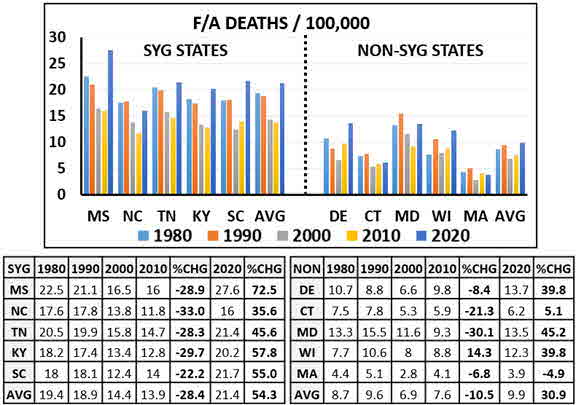
There are two %CHG columns: the one on the left lists percentage change in gun deaths between 1980 and 2010, and the second between 2010 and 2020, the period when most SYG laws came into effect. What’s apparent is that as the periods transitioned, gun death rates in both SYG and non-SYG states, which had been falling across the board, abruptly shifted direction. Of course, given the national uptick in violence that accompanied the pandemic (see that introductory graph) that was to be expected. But the SYG states’ increase seems especially pronounced. CDC data also reports gun homicides. Here are those rates:
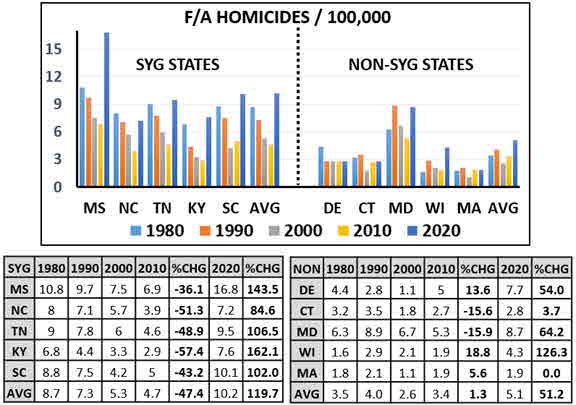
What we’ve seen so far is consistent with concerns that SYG laws, which were mostly enacted after 2010, may have provoked gunplay. Still, non-SYG Delaware, Maryland and Wisconsin also exhibited substantial upticks. Although their rate increases aren’t as drastic, something was driving things. And it wasn’t SYG laws!
What else could it be? We’ve frequently harped about poverty’s strong association with violence (check out that lead table in “Woke up, America!”). Here’s a graph that compares SYG and non-SYG states poverty-wise:
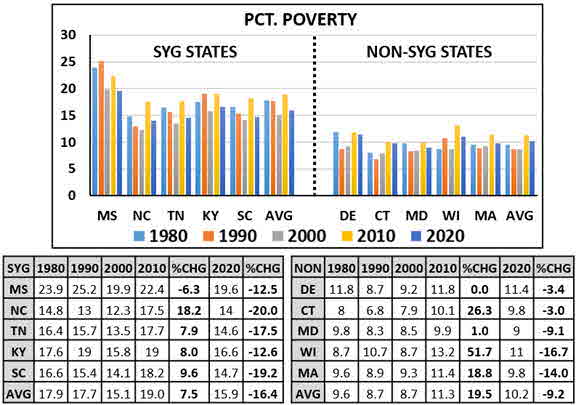
Clearly, there’s a big difference. SYG states have been economically beset for a very long time. In comparison, their non-SYG brethren have basked in affluence. And while that gap lessened over time, it remains observably pronounced.
Political beliefs and gun availability could also be important. This graph uses data from RAND’s estimate of household gun ownership during 1980-2016 by state and the results of Gallup’s 2017 poll of party affiliation:
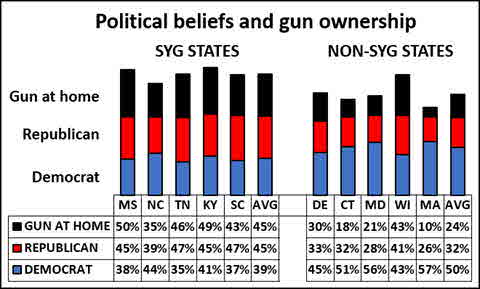
Bottom line: residents of SYG States are considerably more likely to be ideologically conservative and to have (at least one) gun at home.
Be sure to check out our homepage and sign up for our newsletter
So what’s the upshot? Self-help is consistent with conservative political doctrine, which is prominent in SYG states. Residents of SYG states are also more affected by gun violence. And more likely to be dissatisfied with their economic conditions. So it would make perfect sense for them to oppose Government meddling and, as personal safety goes, demand a permissive approach to self-defense. Of course, human nature is fickle. People are fallible, and increased gun availability can greatly worsen the effects of bad decisions. So that same set of circumstances that led thirty states to enact SYG laws may have brought on a lot more than what their boosters intended.
But we haven’t even touched on the consequences of encouraging citizens to use guns on the civil servants who must respond to all shootings, SYG or otherwise. Given the risks of working those unpredictable streets, has it made them more likely to needlessly use lethal force? Check out what happened to that well-intentioned armed citizen in Hemet, Calif. when a cop mistook him for being a bad guy. Police officers, too, are fallible humans. But that’s something for another essay.
UPDATES (scroll)
7/23/25 A new study by Everytown for Gun Safety
blames the "Stand Your Ground Laws" that are now in effect in 29 States for increasing gun homicides by eleven percent, or about 700 deaths
each year. Nonfatal gunshot injuries also substantially increase. According to the report, these laws exercise their unholy effects by
promoting "armed vigilantism" and gun carry, causing a profusion of lethal errors and leading ordinary (but now armed) citizens to turn
resolvable, everyday disputes into deadly tangles.
5/23/25 Oklahoma’s gun laws are decidedly permissive. Since 2019 its residents have been allowed to carry concealed firearms without a permit. Oklahoma is also one of thirty States with a “stand your ground” law, which imposes no requirement to retreat before using lethal force. And a new measure, just signed by Governor Kevin Stitt, empowers Oklahomans who own homes or businesses to point firearms not just in self-defense, but “in defense of their private property.” House bill 2818
8/15/24 Twenty-eight States reportedly allow “permitless carry,” enabling ordinary citizens to pack guns without the need for a record check, special training or a license. According to an analysis by The Trace, sixteen of twenty States that abolished the need for a gun-carry permit between 2015 and 2022 suffered an increase in shooting deaths, not including suicides. At 40.2 percent, West Virginia suffered the highest average monthly increase. Missouri came in at 28.7 percent; Kansas, at 24.9.
5/20/24 Last year, former US Army Sgt. Daniel Perry drew a 25-year prison term for fatally shooting Garrett Foster. In 2020 Perry was working as a ride-share driver Austin when he encountered a pro-Floyd demonstration. He opened fire when Mr. Foster, who was one of the participants, allegedly raised his rifle. Acting on a parole board recommendation, Texas Gov. Greg Abbott just pardoned Perry, releasing him from prison and restoring his gun rights. A strong gun-rights proponent, Gov. Abbott said that Texas’ stand-your-ground law “cannot be nullified by a jury or a progressive district attorney.”
3/18/24 In February Minneapolis-area resident Shannon Gooden, 38, shot and killed two suburban Minneapolis police officers and a paramedic during a domestic violence call. Gooden, who had been convicted of assault with a knife, was barred from having guns. But his live-in companion, Ashley Dyrdahl, who allegedly knew of his record, bought him several, including three AR-15 style rifles. She has now been Federally indicted for doing so.
3/4/24 Twenty-five to life. That’s the sentence handed down to 66-year old Kevin Monahan for murdering the passenger of one of the vehicles that mistakenly drove up the driveway of his rural, upstate New York home. Monahan said he opened fire with a shotgun to “scare the group away” while his wife hid inside. But jurors agreed that his rage was “irrational”, and the judge gave him the maximum penalty for 2nd. degree murder. His victim, 20-year old Kaylin Gillis, has been deeply mourned. (See 1/24/24 update)
2/26/24 Has the unending stream of mass killings made Americans “numb to violence”? That’s what ATF boss Steven Dettelbach fears. Meeting with families of the victims of the October 2023 massacre in Lewiston, Maine, where eighteen were killed, he emphasized that speaking out was crucial. “Your voices are very important...It really makes a difference.” Dettelbach later told reporters that it was “too easy” for unstable persons to get firearms, and that keeping them away from guns was key.
2/19/24 “Senseless” killings plague the land. In San Bernardino, California, an angry motorist reacted to a minor parking lot fender-bender by shooting and killing the driver of the other car. The shooter, who apparently had a serious mental history, used an unregistered 9mm. pistol. She was booked on murder charges.
1/24/24 A New York jury found a 66-year old man guilty of murder in the April 2023 shooting death of a twenty-year old woman who was riding in one of two cars that mistakenly drove up his rural home’s driveway. Jurors rejected Kevin Monahan’s claim that he fired his shotgun to protect himself, and that the fatal round, which came after a “warning shot”, was accidentally discharged. He was also convicted of reckless endangerment and of tampering with evidence, for cleaning the shotgun before police arrived. (See 3/4/24 update)
11/28/23 A brand-new NBC News poll of 1,000 registered voters reports that 52% - a record high - said they or a member of their household owns a gun. That compares with 42% who said so in 2013, and 46% in 2019. Gun ownership was reported as 66% by Republican respondents, 45% by independents, and 41% by Democrats. While percentages have varied, the groups’ relative positions have held steady since 2004.
6/26/23 In August 2022 a small-town South Carolina fire chief and his son used pickup trucks to chase, and ultimately hold at gunpoint, two 17-year old teens who used the chief’s driveway to turn their car around. That pursuit was described as it happened by the frightened teens, who called 9-1-1. Police arrived and had the chief stand down. But the matter’s now the subject of a lawsuit, and a re-investigation by police, which originally took no action. According to Giffords, South Carolina, a stand-your-ground state, authorizes private persons to use deadly force to prevent fleeing from a felony.
An El Paso, Texas Uber driver was shot in June by a visitor from Kentucky who thought that she was involuntarily taken across the border. Phoebe Copas, 48 said she grabbed a pistol from her purse when a freeway sign suggested they were in Mexico. But they weren't, and the driver was following the normal route to her destination. After shooting Daniel Garcia in the head, Copas took his picture, sent it to her boyfriend, and dialed 911. Mr. Garcia has now died, and Copas is charged with his murder.
6/26/23 Stimulated in part by the pandemic, fears of personal safety led to a surge of gun purchase by persons who had not owned a firearm. Meanwhile, gun buying by previous owners “didn’t stop.” Researchers warn that having a gun raises the risk of both homicide and suicide. And of lethal mistakes. Armed persons - including cops - are more likely to perceive (and misperceive) that others are armed: “holding that gun is distorting how you’re seeing the world.” And instead of old-fashioned “duking it out,” access to guns has led to a soaring rate of homicide among teens, who express anger by pulling a trigger.
6/14/23 After an argument “turned physical,” a 45-year old Maryland man pulled a pistol and shot two neighbors dead. He then opened fire with a rifle, killing another man and wounding three others. Annapolis resident Charles Robert Smith was upset that partygoers had been blocking his driveway. He faces three counts of murder, and three of assault. Maryland is not a “stand your ground” State. But its gun homicide problem is considerable, and has been increasing.
6/13/23 Susan Lorincz, the White Florida woman who shot and killed a Black neighbor who angrily pounded on her door, admitted calling the victim’s children the “N word” because of repeated prior instances of “disrespect”. One child said that on the evening of the shooting Lorincz “gave the children the middle finger” and said “get away from my house, you Black slave.” That night Lorincz was reportedly angered because neighbors were “screaming and yelling” and kids “were running around.”
6/7/23 Florida’s “stand your ground” law is the defense offered by a 58-year old woman who fired through her front door, fatally wounding a neighbor. Susan Lorincz is charged with manslaughter and other crimes in the killing of Ajike Owens, a mother of four whose childrens’ behavior was the subject of a long-running, bitter dispute. Lorincz claims that she fired because Owens was trying “to break down her door.” Protests have broken out, spurred by race: the shooter is White, and the victim was Black.
6/2/23 A 58-year old owner of a South Carolina convenience store is charged with murder after shooting and killing a 14-year old boy he and his son chased from the store after wrongly suspecting the youth had shoplifted. During the pursuit, Rick Chow’s son said that the youth had a gun. Chow promptly fired at the teen’s back, inflicting a fatal wound. A handgun was found next to the youth’s body, but there is no indication he pointed it at anyone. Chow, who has often called police to the store, had previously shot at thieves and wounded one. But those episodes were found to be justified. South Carolina has a SYG law. Its laws also let private persons use deadly force to prevent thieves from fleeing in the nighttime.
5/25/23 “I’m here and I have a gun.” Those were the words allegedly uttered at the gates of the CIA’s McLean, Virginia headquarters by Gainsville, Florida man Eric Sandow, 32. He was turned away and police were called. Sandow, who seems free of prior criminal convictions, was later arrested at the nearby preschool where he had parked his car. Inside police found an AK-47 type rifle, a pistol, and a large quantity of ammunition. According to officers, Sandow “exhibited paranoid behavior, irrational verbal behavior, incoherent statements and had an inability to state a plan or purpose”.
5/17/23 A Texas man and his 12-year old son face murder charges after the boy got an AR-style rifle from his father’s vehicle and repeatedly shot a fast-food worker who had tangled with his father during a disturbance outside a Sonic drive-in. Texas has a “stand your ground” law.
5/15/23 “Blues” are hoping that “Red” states, where gun violence has disproportionately increased, will consider gun control measures. And after the March 27 shooting at Covenant school in Nashville, Tennessee legislators dropped plans to arm teachers and let 18-year olds carry guns without a permit. But other “Red” states continue loosening gun laws. In North Carolina, background checks are no longer required for private-party handgun sales. And South Carolina’s governor, who backs stronger penalties for illegal gun possession, favors a bill that would allow carrying a gun without a permit.
5/9/23 When he supposedly “saw shadows outside his home,” Louisiana man David Doyle, 58, opened fire. Those “shadows” were actually children playing hide-and-seek. One bullet from his barrage struck a 14-year girl in the head, but she survived. Doyle faces aggravated assault and battery charges. Louisiana is a stand-your-ground State.
5/3/23 Francisco Oropeza was
arrested without incident. A tip led police to a home about twenty miles away, to which Oropeza was apparantly connected. He
was found him hiding in a closet. Oropeza’s common-law wife has also been arrested, for hindering his apprehension.
In
rural Texas gunfire is commonplace, and police response to these episodes is often delayed. State law generally allows
shooting on one’s property unless it’s done carelessly, and it’s up to counties to forbid the practice
altogether. But San Jacinto County, where Francisco Oropeza massacred his neighbors, never did. According to a local constable,
residents often complained. “I get calls all the time for that...If they’re discharging the weapon in a safe manner,
there’s nothing I can do.”
5/2/23 Francisco Oropeza, who is being sought for murdering five rural Texas neighbors who asked him to stop shooting his AR-15 type rifle late at night, is an illegal immigrant from Mexico and has been deported four times, most recently in 2016. His victims were immigrants from Honduras, and at least one was a legal resident.
|
Did you enjoy this post? Be sure to explore the homepage and topical index!
Home Top Permalink Print/Save Feedback
RELATED WEBSITES
Giffords: “Stand Your Ground” States “Open Carry” States
RELATED POSTS
Gun Massacres special topic
Ideology (Still) Trumps Reason Houston, We Have (Another) Problem
Policing Can’t Fix What Really Ails Is Diversion the Answer? “Legal” Gun Buyers Can be a Problem
When Worlds Collide What’s Up? Violence. Where? Where Else? Worlds Apart - Not!
“Woke” up, America!
Posted 4/4/23
ARE WE HELPLESS TO PREVENT MASSACRES?
A murderous rampage in Nashville suggests that lawmaking is not a solution

For Police Issues by Julius (Jay) Wachtel. When 28-year old Audrey Hale fired through a glass door and barged into Covenant Christian School on March 27, the Nashville resident carried three weapons: a Lead Star Arms “Grunt” AR-15 .223 caliber rifle (left), a Kel-Tec SUB2000 9mm. carbine (right),
and a Smith & Wesson 9mm. pistol. Once inside, Hale roamed the first and second floors of the school, killing three nine-year old students and three adults whom he came across in the hallways. Alerted by the gunfire, teachers promptly locked down their classrooms. Hale fired more rounds – some apparently pierced doors – but he didn’t crash into any rooms and no one else was hurt.
Officers soon arrived and shot Hale dead.
Was Hale legally entitled to have guns? Tennessee does not require background checks for gun purchases. But Federal law prohibits felons and persons who were ever adjudicated mentally defective or committed to a mental institution from acquiring guns. As best we know, none of these categories applied to Hale. So as an adult, Hale could legally purchase guns from Federally-licensed gun stores to their twisted heart’s delight. And Hale did, buying seven guns, including the three used in the massacre, from local sources.
Click here for the complete collection of gun control essays
Could Hale’s parents have done anything? It turns out that Hale was receiving medical care for an emotional condition. His need seems obvious. According to a former classmate, Hale had shared “suicidal thoughts” with her and other acquaintances and “was posting a lot about depression” during the weeks preceding the massacre. Incredibly, Hale messaged her on Instagram moments before it began. “I’m planning to die today...You’ll probably hear about me on the news.” She promptly called a suicide prevention number, then the Sheriff’s Dept. But by that time the slaughter was underway.
Hale’s parents clearly knew that something was seriously amiss. They told police that they did not want Hale to have guns and thought that their child had disposed of the one gun they knew of. In fact, Hale had been training at local gun ranges and kept his seven store-bought weapons, plus two shotguns (one was “sawed-off”), plus lots of ammunition, plus detailed plans for the massacre, at the home. Everything was supposedly well hidden, so it’s possible that the parents were unaware that their adult “child” had an arsenal.
And even had they been inclined to act, there was another obstacle. Nineteen States plus the District of Columbia have so-called “Red Flag” laws that enable judges, based on affidavits from family members or police, to order that guns be seized from possibly dangerous persons. Tennessee does not. So taking Hale’s guns would have required a highly intrusive and time-consuming commitment process. Even in the supposedly “Bluest” of places, liberty interests and due process concerns make preventive gun seizures an intensive, resource-consuming process with an uncertain conclusion. Considering the parents’ apparent “see nothing, hear nothing, know nothing” attitude, that was clearly never in the cards.
 Might society have pre-empted the massacre? Over the decades, America’s experimented with various approaches to deal with troubled citizens. California recently enacted the “Community Assistance, Recovery, and Empowerment Court Program”. Known as CARE, it allows family members, first responders and health workers to seek the detention of troubled persons. If a judge finds cause, individuals can be ordered to participate in a twelve-month plan, renewable once. To help implement the program, Governor Kevin Newsom called for a bond measure that would direct billions to create treatment facilities and long-term supportive housing for the mentally ill. Might society have pre-empted the massacre? Over the decades, America’s experimented with various approaches to deal with troubled citizens. California recently enacted the “Community Assistance, Recovery, and Empowerment Court Program”. Known as CARE, it allows family members, first responders and health workers to seek the detention of troubled persons. If a judge finds cause, individuals can be ordered to participate in a twelve-month plan, renewable once. To help implement the program, Governor Kevin Newsom called for a bond measure that would direct billions to create treatment facilities and long-term supportive housing for the mentally ill.
Many progressively-minded politicians are delighted. Among them is L.A. Mayor Karen Bass, who recently met with the dispirited residents of tent camps that occupy her city’s central core. But not everyone is pleased. Civil liberties groups are concerned that CARE’s coercive underpinnings – after all, we are talking judicial mandates – would reverse decades of reforms that led America to abandon its long-standing practice of institutionalizing the mentally ill. This overhaul began in 1963 with passage of Public Law 88-164, which appropriated $26 million to create facilities that would find the causes of mental disorders and devise practices to ameliorate their effects. According to then-President Kennedy, “new medical, scientific and social tools and insights” would allow mental hospital populations to be slashed in half.
And so they were. Mental institutions across the U.S. emptied. But as rampant homelessness and poor behavior became the “new normal,” critics of deinstitutionalization called the purportedly benevolent approach an appealing fiction. Even reformists were forced to concede that the transition wasn’t producing its intended effects. In their view, while the plan was eminently workable, society had failed to allocate sufficient funds and human resources to carry it through.
What about stricter gun laws? Hale used an AR-15 style .223 caliber rifle and two weapons that fire the 9mm. projectile; one is an assault-style carbine, and the other’s a 9 mm. pistol. Notably, although police responded promptly, all six victims died from their wounds. That’s not surprising. Nine-millimeter rounds are standard police issue and can easily kill. And the .223 cartridge is notoriously lethal. As we pointed out in “Ban the Damned Things” and our Washington Post op-ed, its extreme velocity creates “temporary wound cavities” more than a dozen times the bullet diameter, shattering nearby organs and causing devastating internal damage. (For a graphic depiction of “how bullets from an AR-15 blow the body apart”, click here.)
Recognizing that there is a problem, some progressively-minded places turned to – what else? – lawmaking. To date, nine States and the District of Columbia have enacted assault weapons “bans”, and nineteen States and D.C. have “Red Flag” laws that authorize police to seize guns from allegedly dangerous persons. Such measures have reportedly helped. But loopholes are rampant, and guns that are shorn of doo-dads but fire the same lethal cartridge as the AR-15 are available even in so-called “strong-law” States.
Audrey Hale is the most recent in a long line of deranged shooters whom even the most restrictive laws couldn’t touch. Some, like Frank R. James, who opened fire in the New York City subways last year, had undergone mental treatment. What’s more, he also had a long criminal record. But James had never been “committed” to a mental institution, adjudged mentally defective, or convicted of a felony. As far as the law was concerned, he was free to acquire guns to his heart’s delight. And that’s in a State with gun laws that are supposedly far more restrictive than Tennessee’s. Meanwhile, Federal firearms laws are under severe threat. In its 2020 Bruen decision, the Supreme Court held that “to justify a firearm regulation the government must demonstrate that the regulation is consistent with the Nation’s historical tradition of firearm regulation.” Its ruling, which nullified a New York law requiring that persons who wished to carry a gun justify their reason, was later used by an Indiana-based Federal judge to throw out the conviction of a gun buyer who falsely asserted that he wasn’t facing felony charges. After all, ex-con with a gun laws aren’t “historical,” right?
But forget the Feds. Consider, say, what the highly-respected Giffords website thinks about California’s gun laws:
Overall, California has the strongest gun safety laws in the nation and has been a trailblazer for gun safety reform for the past 30 years.
Impressed? California law bans “assault weapons.” Its definition, though, is quite complex. Here’s an extract:
30515. (a) Notwithstanding Section 30510, “assault weapon” also means any of the following: (1) A semiautomatic, centerfire rifle that does not have a fixed magazine but has any one of the following: (A) A pistol grip that protrudes conspicuously beneath the action of the weapon. (B) A thumbhole stock. (C) A folding or telescoping stock. (D) A grenade launcher or flare launcher. (E) A flash suppressor. (F) A forward pistol grip. (2) A semiautomatic, centerfire rifle that has a fixed magazine with the capacity to accept more than 10 rounds. (3) A semiautomatic, centerfire rifle that has an overall length of less than 30 inches.
Nothing whatsoever is said about caliber (everything below .50 is OK). Now grab a look at “Our Never-Ending American Tragedy.” Here are the “California legal” versions of the rifles Syed Farook and Tashfeen Malik used to murder fifteen in the 2015 San Bernardino massacre (DPMS Panther Arms on the left, Smith & Wesson M&P15 on the right):

And yes, both chamber that insufferably lethal .223 caliber round. Ditto the “Grunt” assault rifle that Hale carried. Is it “California compliant?” Check out Lead Star Arm’s “California Compliant” page.
Our nation’s historically welcoming attitude towards firearms (we’re parodying the Supremes) has enfeebled even the most half-hearted attempts to constrain gun lethality. Guns that mimic Vietnam-era AR-15 assault rifles have long been a major source of profit for the gun industry. Natch, many wound up in the hands of troubled souls. “Gun massacre” became part of the everyday lexicon.
Preventives have proven an appealing fiction. So we must look elsewhere. Meaning, after the fact. And what else is there “after” but the cops? Nashville P.D.’s response has been widely praised. Officers quickly entered the school and gunned down the attacker. Bodycam video indicates that three officers clad in tactical vests and armed with long guns – what appears to be a tactical team – spotted Hale on the second floor. Their quarry ran off, firing “wildly.” But Hale was soon cornered. That encounter, which only consumed a few minutes, has been called far superior to what happened at Robb Elementary in Uvalde, where it took police and hour to confront the shooter.
Be sure to check out our homepage and sign up for our newsletter
 There’s no question but that Nashville cops did an outstanding job. But the comparison with Uvalde isn’t apt. Its cops didn’t have a tactical team on the ready. And the need was obvious, as two of Uvalde’s patrol officers who entered Robb Elementary were quickly wounded (fortunately, only slightly) by .223 caliber rounds that Salvador Ramos fired through a door. Ramos holed up in a room full of students, next to other rooms filled with students. So Uvalde’s cops had to be careful about rushing in with guns. Hale, though, didn’t barge into any occupied classrooms. Indeed, Nashville officer bodycam video depicts a chase through empty rooms and hallways. There’s no question but that Nashville cops did an outstanding job. But the comparison with Uvalde isn’t apt. Its cops didn’t have a tactical team on the ready. And the need was obvious, as two of Uvalde’s patrol officers who entered Robb Elementary were quickly wounded (fortunately, only slightly) by .223 caliber rounds that Salvador Ramos fired through a door. Ramos holed up in a room full of students, next to other rooms filled with students. So Uvalde’s cops had to be careful about rushing in with guns. Hale, though, didn’t barge into any occupied classrooms. Indeed, Nashville officer bodycam video depicts a chase through empty rooms and hallways.
Bottom line: in these days, when every evildoer has access to an assault weapon, all police departments, no matter how “small”, must have a trained, long-gun equipped tactical team on the ready, twenty-four seven. There really is no third choice.
UPDATES (scroll)
6/30/25 A blaze broke out in Canfield Mountain, a popular hiking spot in the hills next to Coeur d’Alene early Sunday afternoon. About a half hour later a sniper opened fire, killing two firefighters and critically wounding a third. Hostile gunfire continued as deputies arrived, and they fired back. Mid-afternoon a cell signal guided a tactical team to the spot where they found a weapon and a man’s body. No information about his identity has yet been released. He is thought to have acted alone.
4/21/25 FSU mass shooter Phoenix Ikner was a deeply troubled child who took meds for “mental issues.” When he was ten his biological mother spirited him away to Norway. A court ordered his return, and she was jailed over the episode. His father remarried, and Ikner, whose birth name was Christian Eriksen, changed his name. Although he did well academically, his “white supremacist, alt-right views” worried classmates, as did his fondness for guns. His stepmother, whose handgun he used, had purchased it from the Leon County Sheriff’s Dept., where she is employed as a deputy. She’s presently on leave. (See below update)
4/18/25 When 20-year old student Phoenix Ikner stepped out of his car at Florida State University, he took out a shotgun. But it jammed. So Ikner reached in and got a handgun. It was an old service weapon once used by his mother, a long-time deputy sheriff. Ikner walked to the area of the student union building and opened fire, killing two non-students and badly wounding five other persons. Officers soon arrived; they shot and wounded Ikner when he didn’t comply with their commands. Ikner was a member of the sheriff’s “Youth Advisory Council” and participated in its training programs. In 2014 a former student opened fire in the FSU library, wounding three. Myron May, 31, was killed by police. (See above update)
10/16/24 According to a noted gun-law analyst, the Supreme Court’s landmark Bruen decision fundamentally reshaped the gun-law landscape. Still, the Court just reinstated, at least for the time being, a Pennsylvania law that bars persons under 21 from carrying guns during declared emergencies. But consequential decisions about “ghost guns,” gun possession by felons and “Red Flag” laws are still in the offing.
9/5/24 In an official White House statement, President Joe Biden cited the Georgia school shooting as providing “even more” reason for “Reds” to partner with “Blues” in enacting “common-sense gun safety legislation.” He proposed re-instituting the Federal ban on assault weapons and high-capacity magazines, mandating safe gun storage, enacting universal background checks (to also cover private sales), and stripping gun manufacturers’ immunity to lawsuits.
6/17/24 According to the AP, America suffered four mass shootings overnight. In a Detroit suburb, a 42-year old man with mental issues but no criminal record opened fire with handguns at a family-oriented suburban “splash pad”. Nine were wounded, two critically. Stephen Huber, the shooter, committed suicide when police closed in at his residence. In another Detroit suburb, a shooting left six wounded. In Massachusetts, gunfire broke out during a party, wounding seven, and two were killed and six were wounded at a Juneteenth gathering in Texas.
2/15/24 Kansas City’s victorious football team had already left on buses when, despite the presence of “more than 800” police officers, gunfire broke out at the end of a parade celebrating the Chief’s Super Bowl victory. One person was killed and twenty-one were wounded, including eight children. Fans pursued several suspects, and three were detained. Several firearms were also recovered.
2/12/24 Accompanied by a young child, an unidentified woman in her thirties walked into a Houston megachurch between services on Sunday afternoon and opened fire with an “AR-15” rifle. Two off-duty police officers working security fired back, killing her. Her child was critically injured, and a parishioner was wounded. Her rifle was reportedly marked “Free Palestine”, but her motives are as yet unknown.
Keep going...
|
Did you enjoy this post? Be sure to explore the homepage and topical index!
Home Top Permalink Print/Save Feedback
RELATED ARTICLES AND OP-EDS
Washington Post feature series on the AR-15
Author’s op-eds: “Want an assault weapons ban that works? Focus on ballistics”
“America is only pretending to regulate lethal firearms”
RELATED POSTS
Gun Massacres special topic Police and the Mentally Ill special topic
Prevention Through Preemption Kids With Guns Houston, We Have (Another) Problem
Policing Can’t Fix What Really Ails Is Diversion the Answer? Cops v. Assault Weapons
When a “Dope” Can’t be “Roped” Loopholes are (Still) Lethal Good Law/Bad Law
Our Never-Ending American Tragedy Ban the Damned Things!
|